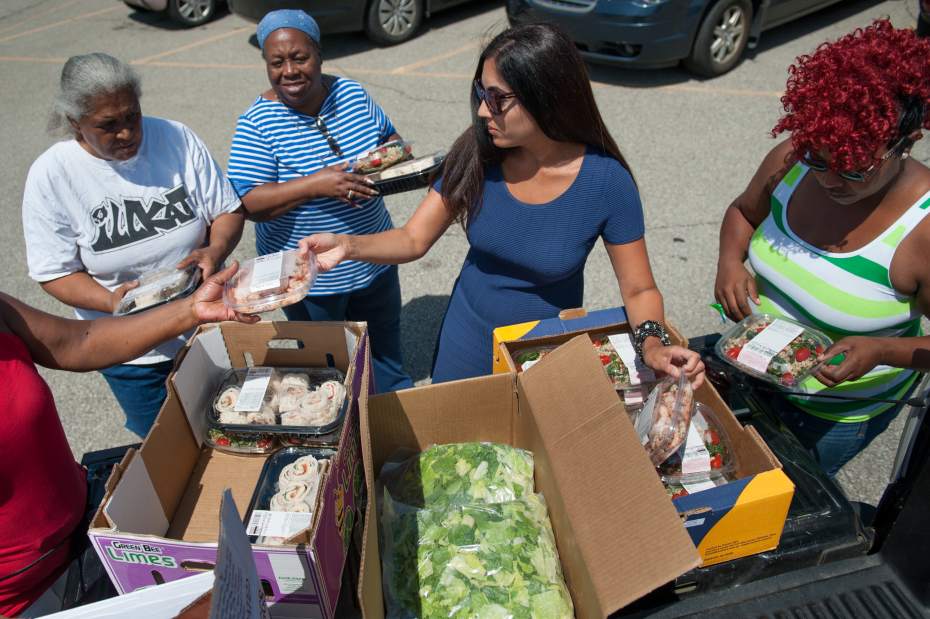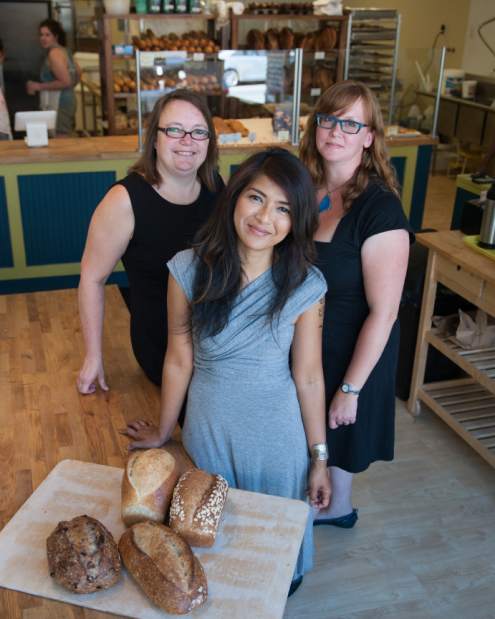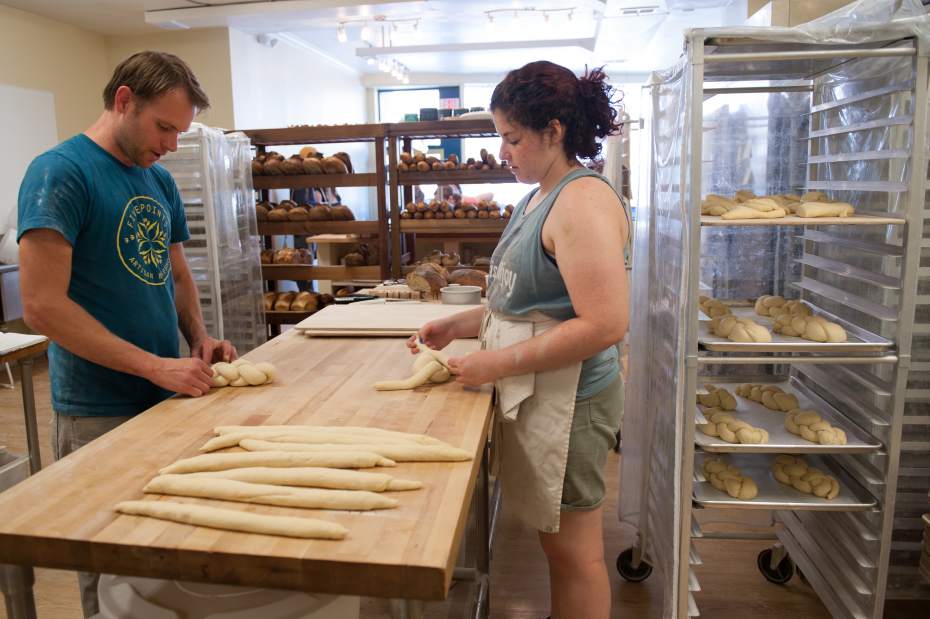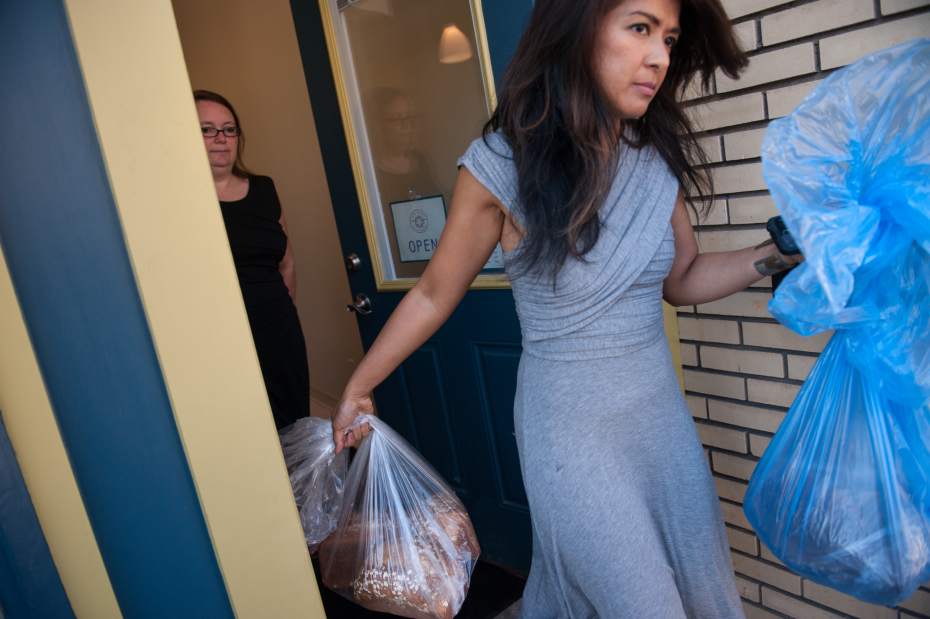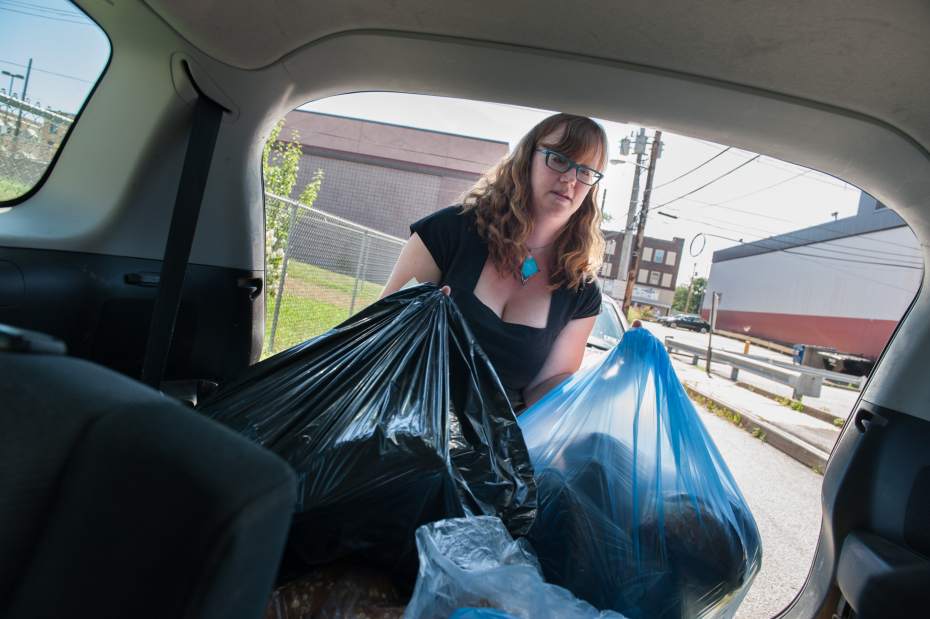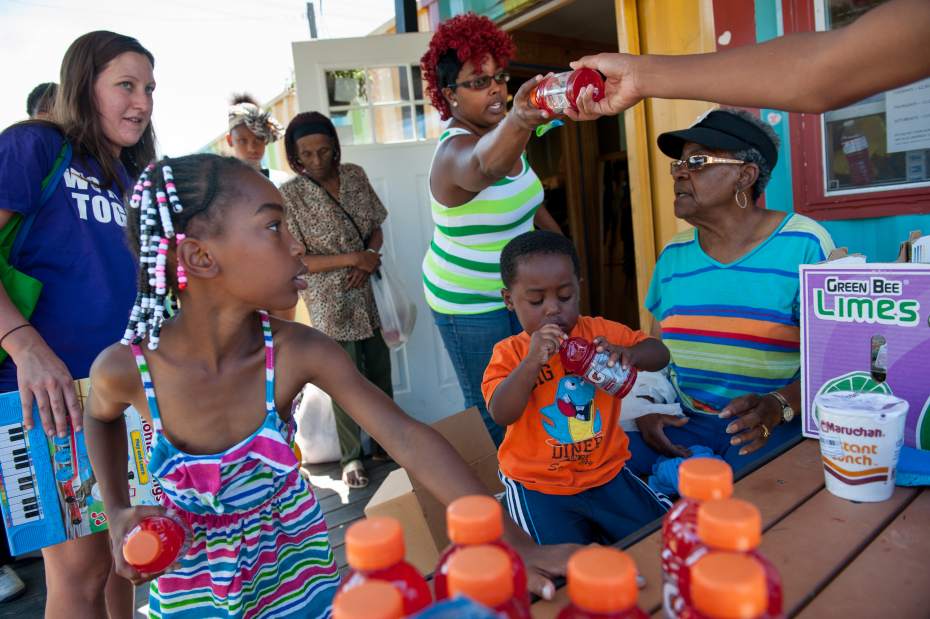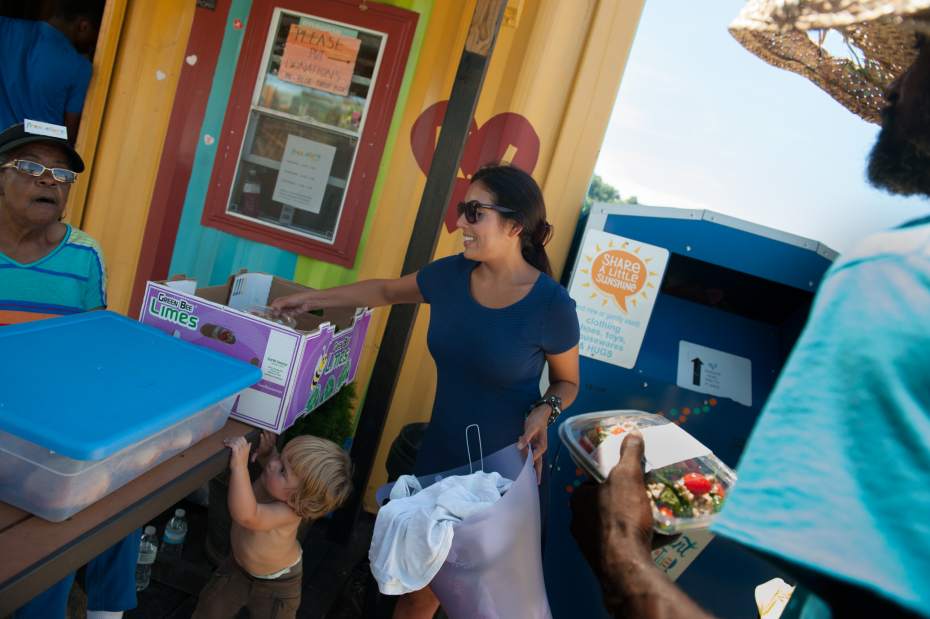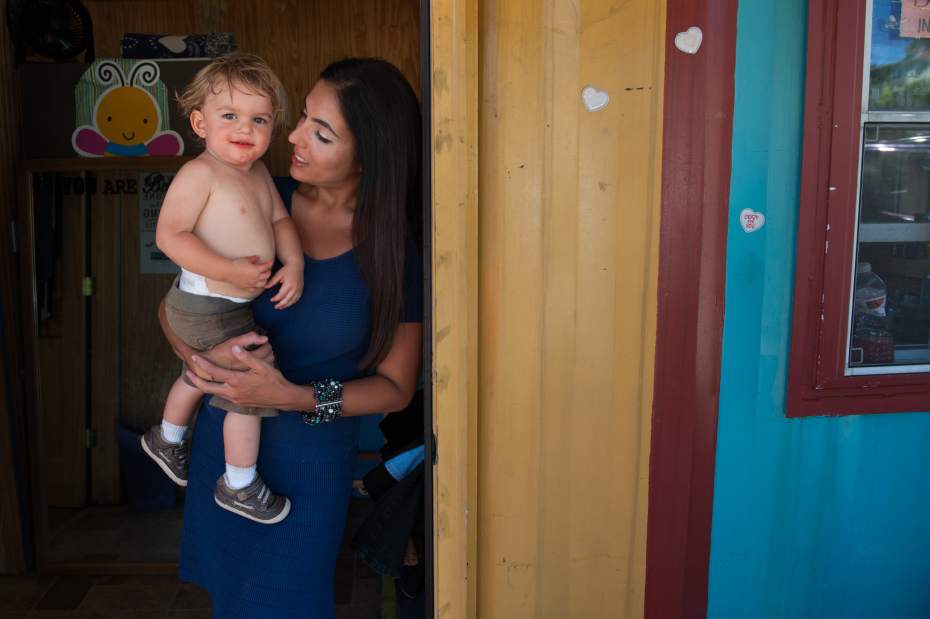Volunteer group matches leftover food to those in need
Forty percent of America's food never gets eaten — it goes right into landfills.
That's 20 pounds of food for each of us, per month, tossed into the trash, according to a recent National Resources Defense Council report.
Yet, millions go hungry. One in six Americans has no steady, secure food supply.
“I know it's higher in some communities,” says Gisele Fetterman, 33, proprietor of the Braddock Free Store and co-founder of 412FoodRescue. “A community like Braddock, for instance, it's a lot higher.”
The problem is everywhere. As many as 171,660 people in Allegheny County are classified as “food insecure,” according to a report by Feeding America. Of those, 43,090 are children.
“Research shows that (food-insecure) kids have inadequate food on the weekend,” says Jennifer England, 46, one of 412FoodRescue's three co-founders. “They come back to school and are hungry. It takes them several days to recover from inadequate nutrition. They're falling behind because of hunger. ‘Backpack projects' address that gap, to make sure they're coming in on Monday ready to learn.”
At the moment, 412FoodRescue regularly donates food for backpack programs at Dilworth and Linden elementary schools in Pittsburgh.
Taken on a worldwide scale, the problem is even worse. All that food waste doesn't just sit passively in landfills. It emits methane. Taken as a whole, food waste is the third largest greenhouse gas-emitter in the world, after the United States and China.
According to a study called “The Food Wastage Footprint” by the Food and Agriculture Organization of the United Nations, the carbon footprint is equal to 3.3 billion tons of carbon dioxide per year, dumped into the atmosphere. Thirty percent of the world's arable farmland is, in effect, wasted.
The scale of the problem seems dauntingly vast — where does one even start?
For Fetterman, it meant arranging to pick up excess food from the Costco in Homestead for Braddock's Free Store 15104, which she runs. It takes donated and surplus items and offers them for free to needy families in Braddock, where her husband, John Fetterman, is mayor.
“I wanted to do something using existing resources, instead of just purchasing food,” Gisele Fetterman says. “We serve close to 1,600 people a month, 400 a week. It's entirely volunteer-run, with one donor, Costco. A mom can call me and say, ‘I don't know what I'm going to do for food on Friday,' and I can set them up.”
While discussing the issue with her friend Leah Lizarondo, 42, of Stanton Heights — a writer, nutritionist, food activist and blogger at The Brazen Kitchen (brazenkitchen.com) — an idea started to take shape. They called it 412FoodRescue.
“I said, ‘You're making a big dent in food insecurity in Braddock,' ” Lizarondo says. “Let's try to do it for the entire county.”
Waste and want
“It's idiotic to throw away food that could be eaten,” says Geof Comings, owner of Five Points Artisan Bakery in Point Breeze.
Yet, he often had to do just that. He and his crew are in the door at 3:30 a.m., kneading dough by hand for rustic sourdough loaves, baguettes, croissants and pastries. When there was extra, Comings found a few places that would take it, but he had to do the deliveries himself.
“There's so much to do when you run a new restaurant,” Comings says. “It required taking time that I didn't have.”
412FoodRescue filled that gap — picking up the excess bread and finding a productive use for it. On a recent Thursday morning, he had about 50 loaves left from the day before. Volunteer Rebecca Maclean was there to pick it up, and made a delivery to the United Way in Ho mewood.
There, Christine Grady of the United Way was leading a group assembling food packages on a picnic table. Nearby, children were examining a potato unearthed in the YMCA's garden. Both sources, vegetables from the garden and bread from Five Points, will go into the packages, as well as food purchased from the Greater Pittsburgh Food Bank.
“It's a pilot program,” Grady says, “delivering to child care facilities in areas that are considered ‘food deserts' ” with no nearby grocery stores.
Food rescue app
“Why don't we do an app like Uber does?” was a thought from Lizarondo.
“Basically, instead of a person being a passenger, it's bread or a case of strawberries,” she says. “Pick it up at a grocery store, and deliver it to an organization who needs it.”
412FoodRescue was a selected project at Steel City Codefest this year, a 24-hour app-building contest for local techies to help local government and community organizations. They plan to have the smartphone app ready by early fall.
At the moment, 412FoodRescue works entirely through its Facebook page. Here's how: One of the 412FoodRescue crew will find a donation and post the location on Facebook. A volunteer will see it, claim it and make the pickup and delivery. If no one responds, one of the three founders will do it.
“We'll post a resource available, and within five minutes, we'll have three people raising their hands, saying ‘I'll do it,' ” Fetterman says.
Volunteers use their own cars.
“The first time I volunteered to pick up a food donation, I saw the request pop up in my Facebook feed,” says Maclean, 37. “It was on a Friday, looking for someone to pick up food in the South Side and take it Downtown before 7 p.m. I work from home on Fridays, and that day, I happened to be making a crockpot dinner for a friend in Brookline. ... I live in Highland Park.
“My thought process was simply, ‘I'm going to be on that side of town anyway, I can come home from Brookline via the South Side and Downtown.' Done. I had my 6-year-old daughter with me, explained to her what we were doing on the way home, and she was excited to help.”
One volunteer, Carmine Parise, a retired airline pilot, can handle bigger loads.
“When he heard about what we were doing, he said ‘That's great,' and went out and bought a refrigerated truck,” Lizarondo says.
“We don't bank food,” says England of Greenfield. “We don't have a facility. ... For every single donation, we look what's in it and figure out where it fits, call them and let them take what they want. It's never an all-or-nothing, take-it-or-leave-it donation.”
They have some large, regular donors, including Gordon Food Services, Whole Foods, Target and the East End Food Co-op, as well as some restaurants, like Carson Street Deli.
“Carson Street Deli has leftover bread all the time,” England says. “During the school year, it was going to the ‘Backpack Project.' Kids and their families loved the bread. Some kids may have never had anything other than sliced Wonder bread, and they're getting amazing baguettes from Breadworks.
“Once, they had made a mistaken order of sandwiches, two trays on the wrong day. So they called us and we know which organizations take pre-made food.”
The Service Access for Youth program, Downtown, for homeless, unaccompanied youth, is one. “They tend to be runaways, or abused and on the street,” England says. “Trays from Carson Street Deli, for them, is lunch for the day. It's a nice, healthy, full meal. It extends their resources.”
It's a challenge to find these organizations, find out what they need, and then not overwhelm them with things they don't need.
“One time I opened the truck, there was so much lettuce on board, I almost fainted,” England says. “What am I going to do with 50 cases of lettuce? Even the big feeding organizations are like ‘Oh, I'll take eight.'
“It turns out, some places have once-a-month food banks, where every family will get a bag of lettuce, which will feed the family for a week. They'll be happy to get it. Something somebody rejects as worthless, somebody else wants. It's like pet adoption. Every food is going to be loved by somebody. There's somebody who wants 5-pound cans of sauerkraut.”
Often, it requires some creativity, a knowledge of local food infrastructure, and luck.
“We had a donation of corn that was buggy,” England says. “It had little worms in it. Commercial kitchens, food pantries and soup kitchens don't want it. So it was definitely going to the landfill.”
But a conversation with the Pittsburgh Zoo directed them to the Wildlife Center, part of the Animal Rescue League. “For them, it actually had value,” England says. “They could find an animal for which that's a tasty meal — corn with larvae already inside.”
Scaling up
The plan is for the smartphone app to make this all run more smoothly.
“A donor will set up an account,” England says. “When they have something to donate, they'll put that in the app. ... I'll get a notification, look at the content of the donation, and will match that with an organization that will use it.”
As long as the food is safe to eat, they'll take it.
“It has to follow certain standards,” England says. “This isn't stuff that's just been sitting in a buffet.”
The Emerson Good Samaritan Food Donation Act protects 412FoodRescue from litigation over donated food.
“Usually, it's highly perishable food — dairy, meat, grains, fruit, vegetables,” Lizarondo says. “When we started, we were intent on redirecting food to hungry people that was healthy — not just Capt'n Crunch. We believe you can't trade one problem for another.
The next step is securing funding.
“We've had a grant from the city, and the Steel City Codefest, a grant from FedEx and the Pittsburgh Foundation,” Lizarondo says. “Near term, we do require foundation support. We are testing. We want to prove this concept will work in Allegheny County. Long term, we want to extend it to different cities, and prove to corporations that it's in their own economic interests to divert waste from landfills. They're going to save on waste management — whatever tonnage we get; they won't have to pay to take it to a landfill.”
Michael Machosky is a staff writer for Trib Total Media. He can be reached at mmachosky@tribweb.com or 412-320-7901.

